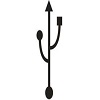USB memory sticks, also called pen drives or flash drives, are used widely for the temporary storage and transfer of large amounts of electronic data. They should not be used as main data storage or to make permanent backups.
You can use USB sticks to keep essential files such as CV's, medical records, and contact lists. Before you save any sensitive information in your USB, be sure to encrypt the drive so the data is protected even if it gets lost. We will show you some links to learn how to do this at the end of the guide.
You’ll need:
- a computer
- document(s) saved on your computer that you want to save to an external drive
- a memory stick
This guide is based on a PC running Windows 10 and other versions may vary.
Follow these step-by-step instructions to use a memory stick
Step 1: Firstly, you need to insert the memory stick into a USB connection port on your PC or laptop. Most USB connection ports can be found on the side of PCs.

To find the correct port look for the USB symbol (see right)
(The memory stick can only be inserted one way into the USB connection port.)
Step 2: Once the device is plugged in, click the Windows icon at the bottom left-hand side of the screen, or use Cortana to search for 'This PC'.
Once you hit File Explorer, hit My PC, you will then see your USB Drive folder.
Step 3: You can now save or copy files to your USB memory stick in exactly the same way you would do to your hard drive. When you save a document make sure you save it to your USB Drive (D:) folder.
Step 4: If you unplug any storage device or removable drive from your computer while it's transferring or saving information, you could lose data. To avoid this, make sure that when you unplug your memory stick, the computer has finished saving any information to it. If your memory stick has a small light that shows when it's in use, wait a few seconds after the light has finished flashing before unplugging it. You can also check by looking for the 'Safely Remove Hardware and Eject Media' icon in the notification area, at the far right of the ‘tray’ at the bottom of the screen. This is an indication that your devices have finished all operations in progress and are ready to be removed.
If you don't see the icon in the ‘tray’, click the Show hidden icons button to display all the icons in the notification area. To safely remove your USB memory stick, click the Safely Remove Hardware and Eject Media icon.
Step 5: A list of devices will appear. Simply click the one that you want to remove.
Step 6: Windows will display a notification telling you, either that the drive is in use and that you should close any programs or windows that might be using it and try again, or that it's safe to remove the device.
Note: You can also safely remove devices by going to My PC, then right clicking on the USB drive folder and hitting Eject.
When using your memory stick, always:
- Avoid contact with extremes of heat, cold, magnetic fields and liquids.
- Remember to use the cap to protect the electrical contacts .
- Remember to safely remove your memory stick and store it safely after use.
- Label your memory stick so it's easily recognisable as yours.
- Although memory sticks are cheap and readily available, your contents may not be! Always keep your data backed-up.
Encrypting your USB drive
Check out Online Tech Tips guide to learn how to securely a USB flash drive (https://www.online-tech-tips.com/computer-tips/encrypt-usb-flash-drive/)
PC world's guide to 3 ways to keep sensitive files encrypted on a flash drive (https://www.pcworld.com/article/2980184/storage/3-ways-to-keep-sensitive-files-encrypted-on-a-flash-drive-or-external-hard-drive.html)
This guide was last updated: 15 June 2022